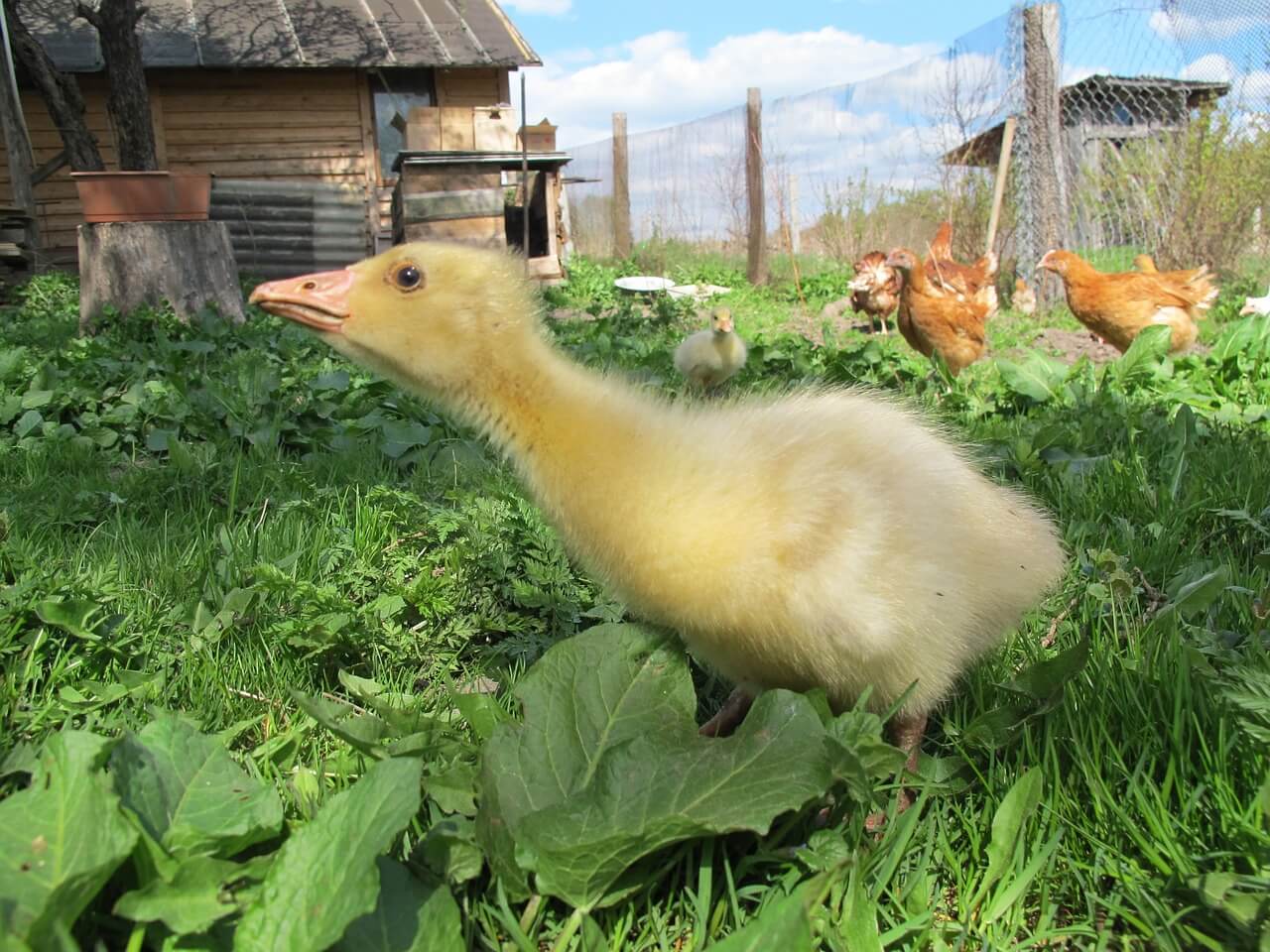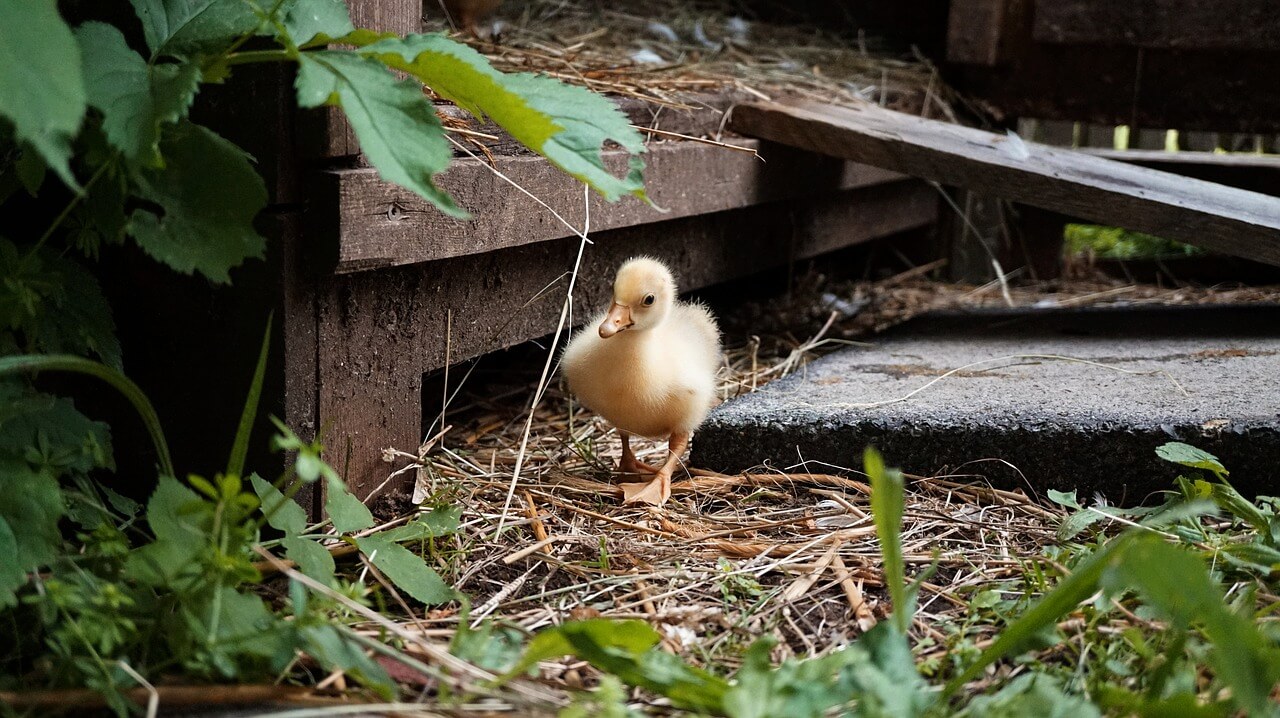If you’re thinking about raising geese, knowing how to care for a baby goose is important. Fortunately, it’s similar to raising other types of poultry, like chicks or ducklings – here’s what you need to know.
What You'll Learn Today
Where Can I Get Baby Geese?

There are a few ways you can acquire baby geese. Unfortunately, geese aren’t known for being wonderful mothers, so it’s often better to give two eggs to a broody hen (to improve your odds) or use an incubator to hatch your eggs.
It takes 30 days to incubate goose eggs, though this is an average, with typical hatching times ranging from 28 to 35 days depending on breed size.
If you’re looking for motivation to start hatching your own eggs, you’ve got to take a look at this adorable video of geese hatching from their eggs in an incubator!
Of course, you can always buy your baby geese from an online hatchery or at a local feed store, too. Incubating eggs can be time-consuming and ordering locally or online takes much of the stress out of the equation.
Hatcheries like Metzer Farms and Cackle Hatchery regularly post specials for goslings for sale.
How Do You Take Care of a Gosling?
Taking care of a gosling isn’t overly complicated. One thing that is important to note is that, if you plan on raising geese, you should keep more than one. These are flock birds who like a little company.
Male geese can be aggressive, but this isn’t always true. Unfortunately, you won’t be able to tell females from males until they’re around nine months old, which is also when females start laying eggs.
Before then, these tips will help you keep your goslings healthy.
What Do You Feed a Baby Goose?
Baby geese can be fed crumbled starter and given fresh water as soon as they arrive on your farm. Use a crumble mix for at least one week to ten days. Then, you can switch to a pellet grower ratio.
Typically, any game bird feed meant for species like ducks, turkeys, and geese will suffice. You will need to make sure your birds have access to feed at all times. Clean, fresh water should also be provided. Goslings consume a shocking amount of water since they grow so quickly.
You may also need to provide some insoluble grit. This helps the chicks digest their food. Put the feed and grit on a paper plate for a few days, then switch to feeders. This will help them get used to it.
When deciding what kind of food to feed your goslings, make sure you only use feed that is designed specifically for geese and ducks. You should never use chick starter on goslings because it can contain medications for the control of coccidiosis. This can be extremely harmful to goslings.
Where Do Baby Geese Sleep at Night?
Some people will put their baby geese in their permanent new homes as soon as they get them home (or as soon as they hatch). However, this isn’t recommended for several reasons.
For one, they can get too cold. For another, goslings are prime targets of predators, including rats. Many people keep goslings in brooder boxes similar to what you’d assemble for other types of poultry, like baby chicks or ducklings.
You can buy a brooder box at the store or you can fashion one out of materials you have lying around the house, like a used Rubbermaid tote or an old bathtub. You can also use a ready-made wire box that’s designed for a large dog, as long as it is placed in a draft-free location.
You will need to put down some sort of bedding. Newspaper isn’t a great idea, since it can be too slippery. Instead, use absorbent materials like newspapers covered with an old towel. Some breeders also suggest wire netting, but it will need to be brushed off from time to time to remove any droppings.
Do Baby Geese Need a Heat Lamp?
Baby geese don’t necessarily need a heat lamp but they do need to be kept warm. Most people use infrared heat lamps but heat plates designed for baby chicks may also fit the bill, depending on your budget and the environment in which you are raising your chicks.
If you use a heat lamp, you will suspend it over the box. You can also suspend it inside the box, but you need to make sure it is securely fastened so the goslings don’t knock it over. This can introduce a fire hazard. Also, make sure your brooder isn’t too hot, as this can make your goslings feather out more slowly.
A starting temperature of 90 degrees right beneath the heat lamp is ideal. Each week, you can reduce the temperature by five to ten degrees until it is at 70 degrees. After about five or six weeks, heat isn’t usually required. As long as the weather conditions allow for it, your geese can be moved outside then.
Housing and Pasturing Goslings
Goslings don’t need any special kind of housing once they leave the brooder. It needs to be ventilated, well-lit, and offer protection from the elements. You can keep them in any type of barn or poultry house.
Typically, this will have a concrete, dirt, or wood floor. Give about one and a half to two square feet of space per bird and cover the floor with absorbent bedding like shavings, sawdust, peat moss, or other matter.
A common misconception about raising geese is that you need to provide them with water for swimming and bathing. While this is true when you are raising ducks, it is not the case with geese. They do like splashing around in ponds but it’s not necessary for their survival.
If you can, let your geese graze as much as possible. They can start grazing when they’re just a few days old (though of course you will want to monitor them carefully and be sure to bring them inside at this time).
By allowing your geese and goslings to eat grass, their natural food, you can dramatically reduce your feed costs. At just six weeks of age, most geese can subsist entirely on quality pasture. For every 20 to 40 birds, you’ll only need one acre of pasture.
Fence in the area with woven wire field fencing. This doesn’t need to be higher than the height of a mature goose, since goslings and adult geese rarely fly. You may also be able to use electric fencing.
How Do You Comfort a Baby Goose?

Baby geese, particularly those that have been separated from the rest of the flock or from their mothers, can be quite timid and nervous. To calm them, the best advice is to start ahead of time. Interact with your baby geese often so that they are used to your presence and are not afraid of you.
You may also be able to calm your baby goose by using treats or playing music, both of which have a relaxing effect on most types of birds.
There are lots of benefits to raising baby geese. They are lovable and friendly – and when you take the time to get to know them and care for them, they’ll quickly become your new favorite pets!